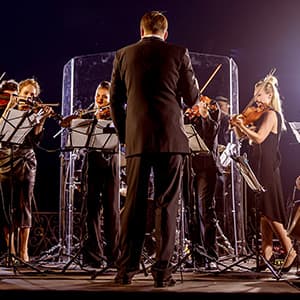

Beethovens Violin Concerto Tickets
Up to 30% Off Compared to Competitors.
Location: Select Location (e.g, New York)
Events Nearby
We're Sorry. There are currently no events near you.
About Beethoven's Violin Concerto
Currently, Beethoven's Violin Concerto continues to be a central piece in orchestral programming around the globe. Renowned violinists often feature it prominently in their concert repertoires, and it is a favorite among soloists in competitions and festivals. In recent months, major orchestras have scheduled performances of the concerto, with notable interpretations by artists such as Hilary Hahn and Joshua Bell, who bring their distinct interpretations to this timeless work. These performances are often accompanied by discussions and lectures that delve into Beethoven's life and the historical context of the concerto, enriching the audience's understanding of the music. Additionally, the concerto has found new life through innovative adaptations and arrangements, including collaborations with contemporary artists and cross-genre projects that aim to bring classical music to a broader audience. Events celebrating Beethoven's legacy, such as festivals and themed concert series, are also prevalent, especially as 2020 marked the 250th anniversary of his birth, leading to a renewed interest in his works. This ongoing appreciation not only highlights the concerto's technical demands and emotional depth but also ensures that Beethoven's Violin Concerto remains a vibrant part of the live music scene, resonating with both seasoned concertgoers and new audiences alike.
Beethoven's Violin Concerto History
Beethoven's Violin Concerto in D major, Op. 61, was composed in 1806 and stands as one of the pivotal works in the violin repertoire. It was written during a period when Beethoven was experiencing profound changes in his personal and professional life, grappling with his increasing deafness while simultaneously asserting his unique voice in the classical music tradition. The concerto was premiered in 1806 by the renowned violinist Franz Clement in Vienna, a city that was a hub for artistic innovation at the time. Initially, the concerto received a lukewarm reception, with critics finding it overly ambitious and complex. However, it has since gained acclaim and is now considered a masterpiece of the concerto form, celebrated for its lyrical melodies, structural innovation, and deep emotional resonance. The work is characterized by its three movements: the expansive Allegro, the lyrical Larghetto, and the spirited Rondo. Each movement showcases the violin's capabilities while also allowing the orchestra to play a significant role, creating a dialogue between the soloist and the ensemble. Over the centuries, it has been interpreted and recorded by countless violinists, each bringing their own flair to Beethoven's intricate lines and harmonies, contributing to the concerto's enduring legacy as a staple in concert halls worldwide.
